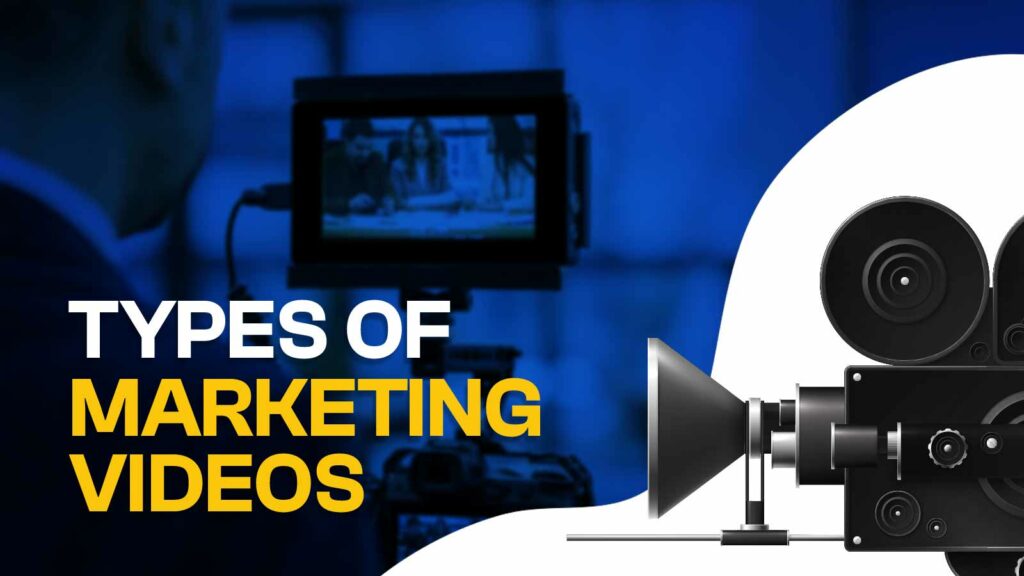
9 Key Benefits Of Video Marketing
In the fast-paced digital landscape, video marketing has emerged as a powerful strategy, revolutionizing how businesses connect with their audiences. This blog explores the key benefits of video marketing, shedding light on the transformative impact it can have on brand awareness, engagement, and overall success.
As attention spans shorten, videos offer a dynamic and compelling way to convey messages, making them an essential tool for modern marketers. From increased audience retention to higher conversion rates, video marketing transcends traditional content approaches.
What Is Video Marketing?

Video marketing involves incorporating videos into your marketing strategy to effectively communicate messages to promote businesses, products, or services. It’s a dynamic approach that leverages the power of visual storytelling to engage and captivate audiences. By utilizing videos, marketers can convey information creatively, making it easier for viewers to understand and remember.
This method fosters a deeper connection with the audience, encouraging increased participation on various social and digital media platforms. Video marketing is an impactful tool for educating audiences, building brand awareness, and establishing a strong online presence, making it an essential component of modern marketing strategies.
Benefits Of Video Marketing

1. Sharing Videos Is A Breeze.
Sharing videos is exceptionally effortless, enhancing the viral potential of your content. The ease of posting videos online makes them highly shareable on social networking platforms.
Leveraging this simplicity, you can encourage visitors to share your compelling video material with their networks, expanding the reach of your message. Videos, being inherently engaging, have ten times the potential for engagement, sharing, and commenting compared to blog articles and other social media content.
The captivating nature of videos prompts quick sharing among viewers who find the content entertaining or interesting. Video marketing proves to be an invaluable tool in rapidly disseminating information about your business and its offerings, leveraging the social connectivity of online platforms.
2. Videos Significantly Boost Conversion Rates.
Videos wield a substantial impact on conversion rates, with an 80% increase attributed to the engaging and easily consumable nature of video content compared to text. Marketers are already witnessing the effectiveness of video marketing, as 70% identify it as the format with the best conversion rates.
The type of video may influence conversion likelihood; product-focused videos, in particular, prove highly engaging, especially for costly items. Demonstrating products in action, often on platforms like YouTube, has a profound effect, as 88% of consumers assert that watching product videos significantly influences their purchasing decisions.
Videos serve as a powerful educational tool, providing customers with in-depth insights that contribute to informed buying decisions, ultimately boosting sales through heightened consumer confidence.
3. Video Content Is Quite Popular
Video content is immensely popular across websites, social media, and platforms like YouTube, constituting one-third of all internet activity. Users dedicate a substantial amount of their online time to watching videos due to the vast array of topics covered.
Video platforms offer a broader spectrum of content compared to traditional television, with YouTube alone hosting videos on nearly every imaginable subject. The authenticity of user-generated content further contributes to its popularity, allowing individuals to create and share their videos.
Viewers resonate with content created by people similar to them. Incorporating videos into your website attracts a diverse audience, making it an effective marketing strategy. The widespread appeal and accessibility of video content make it a dynamic tool for engaging audiences and promoting brand interest.
4. Videos Increase Familiarity With A Brand
Utilizing videos can significantly enhance brand awareness, even if immediate purchases aren’t the immediate outcome. Instead, the video content lingers in viewers’ minds, contributing to heightened brand recognition.
Scientific research underscores this, revealing that employing video marketing leads to a substantial 145% increase in brand awareness. While conversions may not happen instantly, the elevated awareness sets the stage for future conversions.
As individuals recall your brand from the videos they’ve encountered, it establishes a lasting impression. When the time comes for these viewers to make a purchase decision, the familiarity nurtured through video exposure plays a pivotal role, increasing the likelihood of conversions.
In essence, videos serve as a powerful tool for creating a lasting brand presence and fostering connections that translate into future customer engagements.
5. Trust Is Built Via Video Marketing.
Building trust is imperative for a company’s credibility, and video marketing proves instrumental in achieving this goal. Demonstrating your company’s competence and the excellence of your offerings is essential for public perception.
Video content becomes a powerful tool for enhancing consumer trust by providing a tangible showcase of products or services in action. When customers witness a product’s performance through videos, it instills confidence that it will meet their expectations.
Moreover, the investment in creating video content demonstrates a commitment to valuing customers’ time and money. Through thoughtful and informative videos, a company can establish stronger relationships with its audience, fostering a sense of reliability and credibility.
When customers trust a brand, they feel more comfortable making purchases, ultimately contributing to the success and growth of the business.
6. Efficiency Is High For Video Ads.
Video ads stand out for their high efficiency and notable return on investment (ROI), making them a preferred choice for businesses. While video production services necessitate an initial capital investment, the subsequent returns far surpass the upfront costs.
A substantial 80% of company owners affirm that videos yield a positive ROI, underscoring the widespread success and advantages businesses derive from video marketing. Understanding the potential ROI is paramount in crafting a strategic marketing plan, ensuring that chosen tactics translate into a healthy return on investment.
Given its efficacy, any comprehensive marketing strategy should incorporate video marketing as a vital and successful promotional tool, aligning with the industry’s recognition of videos as a high-impact and cost-effective means of engaging and converting audiences.
7. Videos Keep Visitors On Your Pages Longer
Incorporating videos into your website has a profound impact on user engagement, effectively extending the time visitors spend on your pages. The captivating nature of videos plays a crucial role in achieving this, offering several advantages:
Engaging video content reduces bounce rates and keeps visitors from leaving your site prematurely. When viewers find compelling videos, they are more likely to stay longer, exploring additional content and offerings.
Search engines favor websites with higher engagement and longer session durations. By keeping visitors on your pages with engaging videos, you improve your site’s SEO ranking, making it more visible to search engines and potential audiences.
Videos encourage active participation from visitors, fostering a deeper connection with your content. Whether through interactive elements or compelling storytelling, videos create a more immersive and participatory experience, increasing overall engagement.
8. Increased Retention And Understanding:
Videos are powerful tools for conveying information effectively. The combination of visuals, audio, and narrative elements enhances the retention of information. Viewers are more likely to remember key messages presented in a video compared to text-based content.
Additionally, the dynamic nature of videos allows for the demonstration of complex concepts in a simplified manner. Whether through product tutorials or educational content, videos facilitate a deeper understanding, making them an invaluable resource for educating and informing your audience.
9. Global Reach And Accessibility:
Videos break down geographical barriers, enabling your message to reach a global audience. With the prevalence of online platforms and social media, videos can be easily shared and accessed by people around the world.
This global reach enhances brand visibility and allows businesses to connect with diverse demographics. Moreover, videos accommodate various learning styles and preferences, catering to a broad audience.
The accessibility of videos on different devices, from smartphones to desktops, ensures that your content can be consumed conveniently, contributing to a more inclusive and expansive audience engagement strategy.
As a result, businesses can tap into new markets and demographics, broadening their reach and fostering a global presence through the impactful medium of video content.
Types of Marketing Videos

Video marketing employs a variety of formats to engage and connect with audiences effectively. Here are nine main types of videos used in marketing:
Explainer Videos:
These concise videos aim to explain a product, service, or concept straightforwardly and engagingly. Explainers often use animations, graphics, and narration to simplify complex information.
Product Demonstrations:
Showcasing how a product works or highlighting its key features, product demonstration videos provide a hands-on experience for viewers. This type of video is particularly effective for products with unique functionalities.
Testimonials And Reviews:
Featuring satisfied customers or influential figures within an industry, testimonials, and review videos build trust and credibility. Real-life experiences and positive feedback can significantly impact potential customers.
Tutorial And How-To Videos:
Providing step-by-step instructions and tutorial videos assist viewers in learning new skills or using a product effectively. These videos establish authority and can position a brand as an expert in its field.
Behind-The-Scenes Footage:
Offering a glimpse into the inner workings of a company, behind-the-scenes videos humanize a brand. They can showcase the company culture, introduce team members, and provide transparency, fostering a connection with the audience.
Live Videos:
Live streaming on platforms like Facebook, Instagram, or YouTube allows brands to connect with their audience in real time. This interactive format is ideal for Q&A sessions, product launches, or events, fostering a sense of immediacy and authenticity.
Interviews And Conversations:
Conducting interviews with industry experts, thought leaders, or company executives can add value to your content. These videos position your brand within a broader context and provide valuable insights to your audience.
Animated Videos:
Utilizing animation, animated videos are visually engaging and can simplify complex concepts. This format is versatile and often used for educational content, storytelling, or conveying abstract ideas.
User-Generated Content (UGC):
Encouraging your audience to create and share content related to your brand fosters community engagement. UGC videos, such as customer testimonials, unboxing videos, or user experiences, leverage the power of word-of-mouth marketing.
Key Strategies For Video Marketing

Creating a successful video marketing plan involves implementing key strategies to ensure optimal results. Here are seven essential steps to craft an impactful video marketing strategy:
Resource Planning:
To execute a compelling video marketing campaign:
- Allocate a budget for essential resources.
- Invest in quality video tools robust editing software, and dedicate time for production.
- Formulate a skilled video marketing team capable of bringing your vision to life.
Storytelling:
Craft a narrative for each video that resonates with your audience. Clearly define your message and how you want to convey it. Engage viewers by sharing your story authentically, fostering a connection that goes beyond a promotional pitch.
Audience Engagement Planning:
Even with a compelling message, ensure your audience remains interested. Develop a strategy to captivate viewers and maintain their attention throughout the video. Consider incorporating interactive elements or compelling visuals to enhance engagement.
Optimal Video Length:
Acknowledge the “Too long, didn’t read” sentiment by keeping your videos concise. While there’s no fixed duration for videos, shorter formats tend to perform better. Cater to online audiences with short attention spans, ensuring your message is delivered succinctly and effectively.
Saturation and Distribution:
Maximize your video’s reach through saturation. Distribute your video across multiple platforms, including your organization’s website, YouTube, and all relevant social media channels. Utilize your profile pages to enhance visibility. The broader the distribution, the greater the impact.
Results Documentation:
Monitor the performance of your videos by tracking metrics and statistics. Identify which videos garner the most views and analyze popular segments. Take note of common elements that contribute to success. These insights will guide future video creation, allowing you to refine your strategy based on audience preferences.
Iterative Improvement:
Use the documented results to iteratively improve your video marketing strategy. Continuously refine your approach based on audience feedback and evolving trends. Adapt your storytelling, engagement tactics, and distribution channels to stay relevant and effective in the dynamic landscape of video marketing.
How Does Video Marketing Work?

Video marketing is a dynamic strategy that leverages the power of video content to promote and engage with a target audience effectively. Here are seven key points that explain how video marketing works:
Captivating Visual Storytelling:
Video marketing works by telling stories visually, capturing the audience’s attention through compelling narratives. The combination of visuals, audio, and narrative elements creates a more engaging and memorable experience than traditional text-based content. Businesses use videos to convey their brand message, showcase products or services, and connect with their audience on an emotional level.
Enhanced Audience Engagement:
Video content encourages higher levels of audience engagement. Viewers are more likely to watch a video than read a lengthy article, and videos facilitate active participation through comments, likes, and shares. The interactive nature of videos, whether through clickable elements or immersive storytelling, fosters a deeper connection with the audience, leading to increased engagement and brand loyalty.
SEO Boost and Increased Visibility:
Video marketing positively impacts search engine optimization (SEO). Search engines prioritize websites with multimedia content, and videos contribute to longer visitor durations, reduced bounce rates, and improved overall user experience. Optimizing video content with relevant keywords, titles, and descriptions enhances its discoverability, making it more likely to appear in search results and increasing the visibility of your brand.
Social Media Amplification:
Video marketing thrives on social media platforms where content can be easily shared and amplified. Businesses use platforms like YouTube, Facebook, Instagram, and Twitter to reach a wider audience. Social media algorithms prioritize video content, giving it more visibility in users’ feeds. The shareability of videos encourages users to spread the content across their networks, contributing to organic reach and brand exposure.
Conversion and Sales Impact:
Video marketing plays a pivotal role in the conversion funnel. Videos that showcase products, demonstrate their usage, or provide customer testimonials influence purchasing decisions. Studies show that product videos can increase the likelihood of a purchase, and explainer videos contribute to better understanding and trust. By strategically placing videos in the sales journey, businesses can guide potential customers toward conversion and drive sales.
Analytics and Data-Driven Insights:
Video marketing platforms provide robust analytics tools that offer valuable insights into audience behavior. Marketers can track metrics such as view counts, engagement rates, and conversion data to measure the effectiveness of their video campaigns. These insights enable continuous optimization, allowing businesses to refine their video content based on what resonates most with their audience.
Mobile Accessibility and Diverse Content Formats:
With the prevalence of smartphones, video marketing caters to the mobile-centric habits of modern consumers. Mobile-friendly videos are easily accessible anytime, anywhere, contributing to a seamless user experience. Additionally, video marketing embraces diverse content formats, including live streaming, 360-degree videos, and interactive videos, offering versatility in engaging audiences across different platforms and preferences.
The Best Ways to Make Business Videos

Creating professional-quality business videos involves a strategic approach and attention to detail. Follow these key steps to produce engaging and effective videos for your business:
Develop a Screenplay:
Begin with a well-crafted screenplay that outlines the purpose of your video. Clearly communicate the message and aim of the video in an easy-to-understand manner. Ensure the script follows a structured plan, similar to writing a blog article, and avoid leaving crucial information until the end.
Set Up a Recording Studio:
Establish a dedicated recording space equipped with the necessary tools. Ensure good lighting, microphones, tripods, and cameras are ready for filming. A well-prepared recording studio contributes to the overall professionalism and quality of your video content.
Prepare the Talent:
Assemble the video performers with their scripts and instructions. Ensure that everyone involved in the video is well-prepared and understands their roles. This preparation contributes to a smooth filming process and helps capture authentic performances.
Create a Shot List and Familiarize Yourself with Equipment:
Develop a list of shots you want to include in your video and become familiar with the filming equipment. Take some practice shots to ensure you are comfortable with the gear before the actual filming begins. This step helps minimize errors and ensures a more efficient filming process.
Capture the Footage:
Begin filming with a focus on attractive plot points, relevant graphics, and superior audio and video recording capabilities. Craft a compelling call to action and deliver an easily digestible message. Prioritize visuals and narration to keep the audience engaged throughout the video.
Revise the Film:
After capturing the footage, work on a rough cut and seek feedback from stakeholders and interested parties. Revise the video based on their comments and make continuous improvements to enhance the overall quality and effectiveness of the content.
Select Music:
Choose music that complements the mood and tone of your video. Create a list of sound effects and allocate a budget for music licensing if needed. Music plays a crucial role in establishing the emotional atmosphere of the video.
Record Voiceovers:
Voiceovers add depth to your video and fill in any plot holes. Choose voices that resonate with your target audience and record clear and approachable narration. Ensure that the voiceover aligns seamlessly with the visuals and enhances the storytelling.
Upload the Video:
Once the video is finalized, upload it to the desired platforms. Confirm that the video format (MP4, MOV, MPEG4, WMV, AVI, etc.) is compatible with your chosen platform. Consider adding closed captioning, a title, a brief explanation, and a final screen to enhance the overall presentation.
Challenges of Video Marketing

While video marketing offers numerous benefits, it also comes with its set of challenges. Understanding and addressing these challenges is crucial for a successful video marketing strategy. Here are seven challenges associated with video marketing:
High Production Costs:
Creating high-quality videos can be expensive. From hiring professionals for scripting, filming, and editing to investing in equipment and studio space, the production costs can strain budgets. Overcoming this challenge may involve finding cost-effective solutions or prioritizing key video content that aligns with your marketing goals.
Time-Consuming Production Process:
Producing engaging videos takes time, from developing scripts to post-production editing. This time-intensive process can be challenging, especially for businesses with tight deadlines. Efficient planning, streamlined workflows, and the use of video templates can help manage the production timeline effectively.
Staying Consistent with Content:
Consistency is key in video marketing, yet maintaining a regular posting schedule can be challenging. Creating fresh and engaging content consistently requires ongoing effort and creativity. Developing a content calendar and repurposing existing content can help maintain consistency.
Keeping Up with Technological Advances:
The video landscape is constantly evolving with new technologies, platforms, and trends. Staying updated with the latest advancements in video production, editing tools, and distribution channels can be challenging. Regular training and staying informed about industry trends are essential to overcoming this challenge.
Platform Algorithm Changes:
Social media platforms frequently update their algorithms, impacting the visibility and reach of video content. Changes in algorithms can affect engagement metrics and require adjustments to video marketing strategies. Adapting to these algorithm changes and staying flexible in content distribution is necessary for continued success.
Measuring ROI and Effectiveness:
Measuring the return on investment (ROI) of video marketing efforts can be challenging. Determining key performance indicators (KPIs), tracking metrics, and analyzing data are essential components of assessing the effectiveness of video campaigns. Implementing analytics tools and regularly evaluating performance can help address this challenge.
Overcoming Short Attention Spans:
Online audiences often have short attention spans, making it challenging to capture and maintain their focus. Crafting videos that are concise, engaging, and deliver the intended message quickly is crucial. Utilizing attention-grabbing visuals, compelling storytelling, and interactive elements can help address the challenge of short attention spans.
FAQs
What Types Of Businesses Can Benefit From Video Marketing?
Video marketing is versatile and beneficial for a wide range of businesses. Whether you’re in e-commerce, service-oriented industries, or even non-profit sectors, videos can effectively convey your message, showcase products or services, and engage your target audience.
How Does Video Marketing Impact Seo?
Videos positively influence SEO by increasing user engagement. Search engines prioritize content that keeps visitors on a page longer. The longer dwell time associated with video consumption contributes to improved search engine rankings, making video an effective strategy to enhance your online visibility.
Are There Affordable Options For Video Production?
Yes, affordable options for video production exist. With the accessibility of smartphones and user-friendly editing software, businesses can create compelling videos without significant investments. Additionally, outsourcing specific aspects of production or utilizing freelancers can help manage costs effectively.
Can Video Marketing Work For Small Businesses?
Absolutely. In fact, video marketing can be particularly impactful for small businesses. It provides an opportunity to showcase personality, connect with the local community, and compete on a more level playing field with larger competitors. Authenticity and creativity often matter more than budget size.
How Long Should A Marketing Video Be?
The ideal length of a marketing video varies depending on the platform and content. However, shorter videos are generally more effective, especially for online audiences with short attention spans. Aim for concise, engaging content, keeping most videos between 1 to 2 minutes for optimal viewer retention.
Can Video Marketing Help In Customer Retention?
Yes, video marketing plays a crucial role in customer retention. Regularly providing valuable and engaging video content keeps your audience connected to your brand. Whether it’s tutorials, updates, or behind-the-scenes footage, videos contribute to building a sense of community and loyalty among customers.
How Can Businesses Measure The Success Of Their Video Marketing Campaigns?
Success in video marketing can be measured through various metrics, including view counts, engagement rates, conversion rates, and audience feedback. Analyzing these metrics allows businesses to refine their strategies, understand what resonates with their audience, and continually improve the effectiveness of their video content.
Is Video Marketing Worth It?
Video marketing is unquestionably worth the investment. With the rise of online content consumption, videos have become a dominant force in capturing audience attention. The engagement potential of videos is unparalleled, fostering a deeper connection with viewers. Moreover, studies consistently highlight the positive impact of video marketing on brand awareness, conversion rates, and overall ROI.
Videos convey messages more effectively, making information easily digestible for audiences with diverse preferences. As an engaging and shareable medium, video marketing propels brand visibility, driving meaningful interactions. In the evolving digital landscape, the value of video marketing transcends trends, proving itself as a strategic and indispensable tool for businesses aiming to thrive in the competitive online sphere.

















































